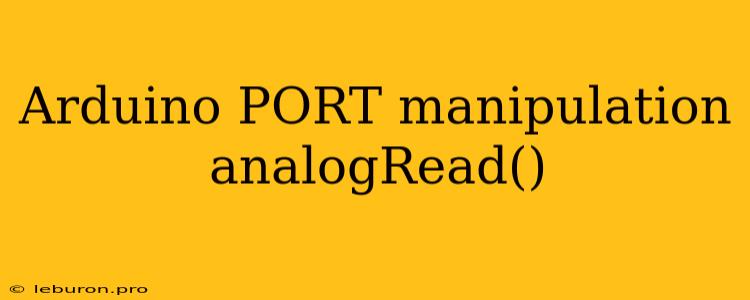Arduino is a popular platform for hobbyists and professionals alike, offering a wide range of possibilities for building interactive projects. One of the key features of Arduino is its ability to interact with the physical world through its digital and analog input and output pins. While digital pins are used for on/off signals, analog pins are crucial for reading varying values, like those from sensors or potentiometers. The analogRead() function in Arduino allows you to read analog values from these pins, but understanding how these values relate to real-world measurements requires a deeper dive into the underlying PORT manipulation.
Understanding the Analog-to-Digital Converter (ADC)
The Arduino's analogRead() function relies on an internal component called the Analog-to-Digital Converter (ADC). The ADC is essentially a circuit that transforms the analog voltage on an input pin into a digital value that the Arduino can understand and process. This process involves sampling the analog voltage at specific intervals and converting it into a digital representation.
The ADC in most Arduino boards has a fixed resolution, meaning it can only represent a limited number of discrete values. The Arduino Uno, for instance, has a 10-bit ADC, which means it can represent 2^10 (1024) unique values.
The Role of PORT Manipulation in analogRead()
To read analog values, the Arduino uses a specific set of registers associated with its PORTs. These registers are memory locations that control the behavior of the digital and analog pins. When you call the analogRead() function, the Arduino:
-
Selects the Analog Input Pin: The Arduino internally configures the selected analog input pin to be connected to the ADC. This involves setting the appropriate bits in the PORT registers.
-
Starts the Conversion Process: The Arduino initiates the conversion process by sending a signal to the ADC, instructing it to sample and digitize the analog voltage on the selected pin.
-
Waits for Conversion Completion: The ADC takes some time to perform the conversion. The Arduino typically waits until the conversion is complete before reading the resulting digital value.
-
Reads the Digital Value: Once the conversion is finished, the Arduino reads the resulting digital value from the ADC's result register. This value represents the sampled analog voltage, but in a discrete digital form.
Working with analogRead() and PORT Manipulation: An Example
Let's look at a simple example to illustrate how analogRead() works in conjunction with PORT manipulation. Imagine you're using a potentiometer connected to an Arduino analog input pin, say pin A0. Here's how the process unfolds:
-
Connecting the Potentiometer: You connect the potentiometer's wiper to pin A0, the positive leg to the Arduino's 5V pin, and the negative leg to ground. This creates a variable voltage divider circuit, where the voltage at pin A0 varies as you turn the potentiometer knob.
-
Calling analogRead(): When you call
analogRead(A0), the Arduino initiates the ADC conversion process. It sets the appropriate PORT registers to connect pin A0 to the ADC. -
Reading the Value: After the ADC completes the conversion, the Arduino reads the digital value from the ADC's result register. This value will be between 0 and 1023 (for a 10-bit ADC), representing the analog voltage at pin A0.
-
Mapping to Real-World Units: You can then map the digital value from
analogRead()to real-world units, based on the specific characteristics of the potentiometer and the ADC's resolution. For example, if the potentiometer has a maximum resistance of 10kΩ, you can calculate the corresponding voltage and map the digital value accordingly.
Beyond analogRead(): Direct PORT Manipulation for Advanced Applications
While analogRead() provides a convenient way to read analog values, advanced applications might require more direct control over the ADC process. In such cases, you might need to manipulate the ADC's registers directly using low-level commands. This approach offers finer-grained control, allowing you to:
- Configure ADC Settings: Change the ADC's resolution, sampling rate, and other parameters.
- Trigger Conversions Manually: Initiate conversions at specific times or intervals.
- Access Raw ADC Data: Read the unprocessed ADC output directly, bypassing the
analogRead()function.
However, direct PORT manipulation requires a deeper understanding of the Arduino's hardware architecture and involves dealing with low-level registers and memory addresses. It's often a more complex approach suitable for advanced users who require full customization of the ADC process.
Conclusion
Understanding how analogRead() works in conjunction with PORT manipulation is crucial for effectively using analog input on your Arduino projects. By knowing the underlying ADC process and the role of the PORT registers, you can better interpret the values obtained from analogRead(), map them to real-world units, and even optimize the ADC's performance for specific applications. While analogRead() provides a simple interface for most use cases, direct PORT manipulation opens up possibilities for advanced control and customization, allowing you to unlock the full potential of your Arduino's analog capabilities.
